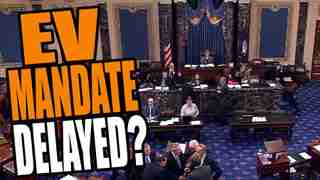Electric Vehicle Mandates Face Renewed Opposition From Dealers

Table of Contents
Concerns Regarding Inventory and Infrastructure
The transition to electric vehicles presents considerable challenges for dealerships, impacting both inventory management and the necessary infrastructure.
Challenges in Managing EV Inventory
Dealerships face several hurdles in effectively managing their EV inventory:
- Higher upfront costs of EVs: Electric vehicles often have significantly higher purchase prices than comparable gasoline-powered vehicles, requiring dealers to tie up more capital in inventory. This is especially challenging for smaller dealerships with limited financial resources.
- Limited consumer understanding: Many consumers remain hesitant about EVs due to misconceptions about range, charging times, and battery lifespan. This uncertainty makes it difficult for dealers to accurately predict demand for specific EV models.
- Difficulties in predicting demand for specific EV models: The EV market is still evolving rapidly, with new models and technologies constantly emerging. This makes accurate demand forecasting challenging, leading to potential overstocking or shortages of specific models.
- Concerns about battery technology longevity: Concerns about battery degradation and replacement costs impact consumer confidence and create uncertainty for dealers regarding long-term warranty claims.
- The need for specialized EV service training for mechanics: Servicing EVs requires specialized tools, training, and knowledge, adding to the cost burden for dealerships. Mechanics need to be trained on high-voltage systems and battery maintenance, representing a significant investment.
The logistical challenges of storing and managing EV inventory are considerable. Unlike gasoline vehicles, EVs often require specialized charging infrastructure within the dealership, increasing both setup and ongoing maintenance costs. This adds to the complexities of managing inventory compared to traditional internal combustion engine (ICE) vehicles.
Insufficient Charging Infrastructure
The lack of a robust public charging infrastructure is a major obstacle to widespread EV adoption and a key driver of dealer opposition to mandates.
- Lack of widespread public charging stations: The density of public charging stations, particularly fast-charging stations, remains insufficient in many areas, causing range anxiety among potential EV buyers.
- Uneven distribution of charging networks: Charging stations are often clustered in urban areas, leaving rural communities underserved. This disparity hinders EV adoption in less densely populated regions.
- Range anxiety among consumers: The fear of running out of battery power before reaching a charging station remains a significant barrier to EV adoption. This is exacerbated by the inconsistent availability of charging stations.
- Long charging times compared to refueling: Charging an EV takes significantly longer than refueling a gasoline vehicle, impacting convenience and potentially hindering EV adoption.
- Inconsistencies in charging standards across different manufacturers: The lack of standardization in charging connectors and protocols adds to consumer confusion and complicates the development of a unified charging infrastructure.
The inadequate charging infrastructure not only impacts consumer confidence but also creates operational challenges for dealerships. Dealerships are increasingly pressured to offer charging solutions, but the high costs and logistical complexities of setting up on-site charging facilities represent a significant burden.
Financial Impact on Dealerships
The transition to EVs places considerable financial strain on dealerships.
Investment Costs in EV-Specific Equipment and Training
Adapting to the EV era requires significant upfront investments for dealerships:
- High initial investment required for specialized EV charging equipment: Installing fast chargers and other EV-specific equipment necessitates substantial capital expenditure.
- Need for trained technicians to handle EV repairs: Dealerships must invest in training their mechanics to service high-voltage systems and EV-specific components.
- Potential loss of revenue from reduced service needs (e.g., fewer oil changes): EVs require less frequent maintenance than gasoline vehicles, potentially leading to decreased service revenue for dealerships.
- Increased training costs for staff: Sales staff also need training to effectively sell and explain the benefits of EVs to customers.
These investments represent a considerable financial burden, especially for smaller dealerships with limited financial resources. The return on investment is uncertain given the evolving EV market and the potential for lower profit margins on EV sales.
Impact on Profit Margins
The shift towards electric vehicles significantly impacts dealership profitability:
- Lower profit margins on EVs compared to traditional vehicles in some cases: The higher purchase price of EVs doesn't always translate into proportionally higher profit margins for dealerships.
- Potential for increased warranty claims related to battery technology: Battery technology is still evolving, potentially increasing the risk of warranty claims related to battery failures or performance issues.
- Pressure to offer competitive pricing in a growing EV market: Intense competition in the growing EV market forces dealerships to offer competitive pricing, potentially squeezing profit margins.
- Reduced sales volume due to consumer hesitation: Consumer hesitancy towards EVs, fueled by range anxiety and other concerns, can reduce sales volume and negatively impact dealership profitability.
The financial pressures on dealerships are substantial, and many are struggling to reconcile the high investment costs with potentially lower profit margins on EV sales.
Consumer Demand and Market Readiness
The success of electric vehicle mandates hinges on consumer acceptance and market readiness.
Limited Consumer Awareness and Understanding
Several factors hinder widespread consumer adoption of EVs:
- Lack of consumer awareness about government incentives: Many consumers are unaware of the various government incentives and rebates available for purchasing EVs.
- Misconceptions about EV performance and practicality: Common misconceptions include limited range, long charging times, and lack of charging infrastructure.
- Concerns about battery lifespan and resale value: Consumers are often concerned about the longevity of EV batteries and the resale value of used EVs.
- The perceived higher purchase price of EVs: The higher initial purchase price of EVs remains a significant barrier to adoption for many consumers.
Addressing these misconceptions and improving consumer awareness about EV benefits and government incentives is crucial for driving demand.
Regional Variations in EV Adoption
EV adoption rates vary significantly across different regions:
- Differences in EV adoption rates across geographical areas: Adoption rates are generally higher in urban areas with better charging infrastructure and more environmentally conscious consumers.
- Varying levels of government support for EVs: Government incentives and policies vary significantly across regions, impacting consumer demand and dealer investment decisions.
- Disparities in charging infrastructure availability: The lack of widespread charging infrastructure in certain regions hinders EV adoption.
- Regional differences in consumer preferences and driving habits: Consumer preferences and driving habits vary across different regions, influencing EV adoption rates.
Understanding these regional variations is crucial for developing effective policies that support EV adoption while addressing specific regional challenges.
Conclusion
The renewed opposition to electric vehicle mandates from auto dealers highlights significant challenges in the transition to an all-electric future. Concerns about inventory management, charging infrastructure, financial impact, and consumer readiness underscore the need for a more nuanced and collaborative approach to implementing these policies. A balanced approach that considers the concerns of dealerships while upholding the goals of environmental sustainability is crucial for the successful adoption of electric vehicles. Understanding the intricacies of the opposition to electric vehicle mandates, including the financial burdens on dealerships and the need for improved charging infrastructure and consumer education, is key to creating policies that support both environmental progress and economic viability within the automotive industry. Addressing these concerns effectively will be critical to the successful implementation of future electric vehicle mandates and the overall transition to a more sustainable transportation system.

Featured Posts
-
 The Tush Push Triumphs The Nfl Ends Its Controversial Celebration Ban
May 23, 2025
The Tush Push Triumphs The Nfl Ends Its Controversial Celebration Ban
May 23, 2025 -
 Emlyt Washntn Hl Athart Srkht Rwdryghyz Ldem Alhryt Lflstyn Nqasha Ealmya
May 23, 2025
Emlyt Washntn Hl Athart Srkht Rwdryghyz Ldem Alhryt Lflstyn Nqasha Ealmya
May 23, 2025 -
 Big Rig Rock Report 3 12 Mastering Rock 101 Fundamentals
May 23, 2025
Big Rig Rock Report 3 12 Mastering Rock 101 Fundamentals
May 23, 2025 -
 The Who The Untold Story Behind Their Iconic Name
May 23, 2025
The Who The Untold Story Behind Their Iconic Name
May 23, 2025 -
 900 Euro Fuer Bessere Noten Skandal An Der Universitaet Duisburg Essen
May 23, 2025
900 Euro Fuer Bessere Noten Skandal An Der Universitaet Duisburg Essen
May 23, 2025
Latest Posts
-
 Ferrari Challenge Racing Days Dominate South Florida
May 24, 2025
Ferrari Challenge Racing Days Dominate South Florida
May 24, 2025 -
 Mamma Mia A Closer Look At The New Ferrari Hot Wheels
May 24, 2025
Mamma Mia A Closer Look At The New Ferrari Hot Wheels
May 24, 2025 -
 Mamma Mia The Hottest New Ferrari Hot Wheels Sets
May 24, 2025
Mamma Mia The Hottest New Ferrari Hot Wheels Sets
May 24, 2025 -
 New Hot Wheels Ferrari Sets A Mamma Mia Moment For Collectors
May 24, 2025
New Hot Wheels Ferrari Sets A Mamma Mia Moment For Collectors
May 24, 2025 -
 10 Fastest Standard Production Ferraris Official Track Performance Data
May 24, 2025
10 Fastest Standard Production Ferraris Official Track Performance Data
May 24, 2025
